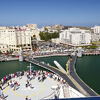8 Nights | Caribbean/Bahamas
You will visit the following 5 places:

San Juan
San Juan, officially Municipio de la Ciudad Capital San Juan Bautista (Municipality of the Capital City, Saint John the Baptist), is the capital and most populous municipality in Puerto Rico, an unincorporated territory of the United States. As of the 2000 census, it has a population of 658,304 making it the 42nd-largest city under the jurisdiction of the United States. San Juan was founded by Spanish colonists in 1521, who called it Ciudad de Puerto Rico ("Rich Port City"). Puerto Rico's capital is the second oldest European-established city in the Americas, after Santo Domingo, in the Dominican Republic. Several historical buildings are located in San Juan; among the most notable are the city's former defensive forts, Fort San Felipe del Morro and Fort San Cristóbal, and La Fortaleza, the oldest executive mansion in continuous use in the Americas.

Oranjestad
Oranjestad, known as ("Orange Town"), is the capital and largest city of Aruba. In the local language, Papiamento, Oranjestad is also often referred to simply as "Playa". The city consists of hundreds of local stores where tourists usually buy their keepsakes. The city is also home to some of the island's local residents and also many governmental buildings. Along the main "drag" (Sasakiweg street) you will find most tourist walking around and shopping and can also see the cruise ships that bring more and more external tourism into the island everyday. Close to the cruise ships is the island's largest marina where you can find great docking space for your vessel.

Willemstad
Willemstad is the capital city of Curaçao, an island in the southern Caribbean Sea that forms a constituent country of the Kingdom of the Netherlands. Formerly the capital of the Netherlands Antilles prior to its dissolution in 2010, it has an estimated population of 150,000. Willemstad is home to the Curaçao synagogue, the oldest surviving synagogue in the Americas.

St. Johns

Phillipsburg
Phillipsburg is a town in Warren County, New Jersey, in the United States. It was incorporated as a town by an act of the New Jersey Legislature on March 8, 1861, from portions of Phillipsburg Township (now Lopatcong Township). The town was named for William Phillips, an early settler of the area. Phillipsburg had historically benefited from being a major transportation hub, situated at the confluence of the Delaware and Lehigh rivers. Phillipsburg served as the western terminus of the Morris Canal for approximately 100 years from the 1820s to 1920s, which connected the city by water to the industrial and consumer centers of the New York City area, with connections westward via the Lehigh Canal and Delaware Canal across the Delaware.








